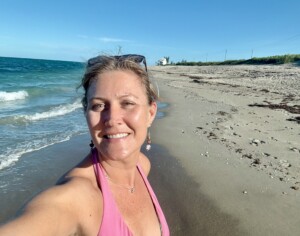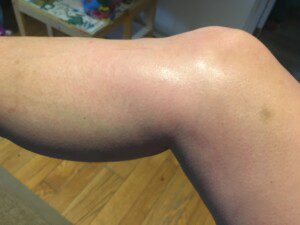Written by Andi Kohler for the RSDSA blog. Views expressed in content belong to the guest bloggers and not the organization, its affiliates, or employees.

How and when did you develop CRPS?
I developed CRPS in 2000 from a grade II MCL tear in my knee. The tear was non-surgical and my excruciating pain was out of proportion to the injury. Upon initially tearing the ligament, my leg turn ice cold and purple from the knee down to my toes and I could not move this area.
What has daily life been like since your diagnosis?
A rollercoaster, depending on the year and various other injuries/surgeries. It has been daily management of varying degrees of unseen pain, and a mental battle to overcome. I’ve had to work to overpower a negative and depressed mindset.
What is one thing you wish those without CRPS could understand?
Prioritize yourself, always. Anyone should do this really, but especially CRPS Warriors. Be brave and dive deep into past traumas, healing yourself and forgiving. I find that neglecting to do this fuels the monster of pain inside us.
What advice would you give to newly diagnosed Warriors?
Always be your own advocate, especially within the medical system. Fight until you find a team of doctors that will listen to you, support you and research for you. Do your own research. Opioids make CRPS worse over time. Having been on opioids on and off for nine years and eventually stopping them in order to pursue ketamine infusions, I can absolutely say medications that target nerve pain and inflammation in the brain are far superior for long-term management of CRPS.
What encouragement would you give to Warriors who have had CRPS for many years?
You can always decrease your pain and go into remission. I’ve had CRPS for 25 years. It started in my lower right leg and over the years due to stress and additional surgeries, I now have CRPS in all four limbs. In theory, it has affected my bladder and stomach as well. I was on full time disability for seven years and a year ago I was able to start working. I now work full-time and am coming off disability. Your doctors have to guide and advise you, however they are not a replacement for the overwhelming power your mind has. Keep a positive attitude, heal your emotional traumas, focus on a healthy diet and lifestyle, and advocate for your well being.
What activities or treatments have helped you find temporary or long term relief?

Physical therapy and graded motor imagery have really helped me, but always in conjunction with medical management.
Sympathetic blocks were tremendously helpful. I’ve received them for my leg and my arm. However, their effectiveness does wear off over time with repeated injections.
Spinal cord stimulator – I use mine 24/7 and could not function without it.
Ketamine infusions – I received these miraculous treatments for six years every month. I started once a month and ended with three days a month. I would go into my sessions barely able to walk with a cane and come out of the infusions walking normally with no limp and able to sustain a mile walk.
Muscle relaxants – I take Baclofen, it does wonders for the the muscle cramping and dystonia that can happen as a sequelae to CRPS.
Low-dose Naltrexone – I take this daily and can’t function without it. It is wonderful for reducing pain and is not an opioid.
Diet – I stick to a strict anti-inflammatory diet with no dairy, no gluten and no red meat. If I eat sugar or go off this diet, I feel so swollen, stiff, and achey the next day. It’s not worth it to me!
Exercise – Even if you can barely walk around your house, still find a way to move every single day. Yoga is very helpful at any stage of CRPS as it stretches your soft tissues and muscles while building strength in a subtle way. You can even do yoga while in a chair. At one point three years ago, I could hardly walk without a cane and could only stretch. Now, I do yoga and pilates plus go to the gym for weights, etc. 4x a week. This was a slow and very gradual progression of healing my body, but I kept a positive attitude, even if the achievement of the day was getting out of bed. A year and a half ago I was in 8-10/10 pain every moment of every day and now I am in 3-5/10 pain and working full time.
Anything else you would like to add?
I think our mental health and the way we process thoughts is extremely important to managing our pain. I meditate daily, practice mindfulness and say positive affirmations of gratitude, especially when I’m feeling sorry for myself or painful. It works, I promise.
If you are unhappy in your life, change it. For me, I tended to stuff my emotions deep inside but I find that this makes my pain worse. I prioritize putting myself and living in positive, uplifting environments with similar types of people. It takes so much energy to manage our pain and mental health as CRPS warriors, I think surrounding ourselves with joyous, supportive and happy people is crucial. I’ve made drastic changes in my life within the last year in order to make this happen, and it has paid off exponentially in enhancing my mental and physical well-being.
I have also been on an intense emotional healing journey for about five years. I see a counselor weekly, work on self-help and improvement workbooks, and I’ve healed my severe childhood trauma. This greatly reduced my CRPS symptoms and I am so much healthier and happier because of it.
Managing CRPS is a multi-model approach involving exercise, physical therapy, diet, mental awareness, medications and sometimes interventional surgical/therapeutic management. I do not believe there is currently a magic pill to treat this disease, so it is up to us to find our enhanced protocol and system to living our best life while managing our CRPS.
